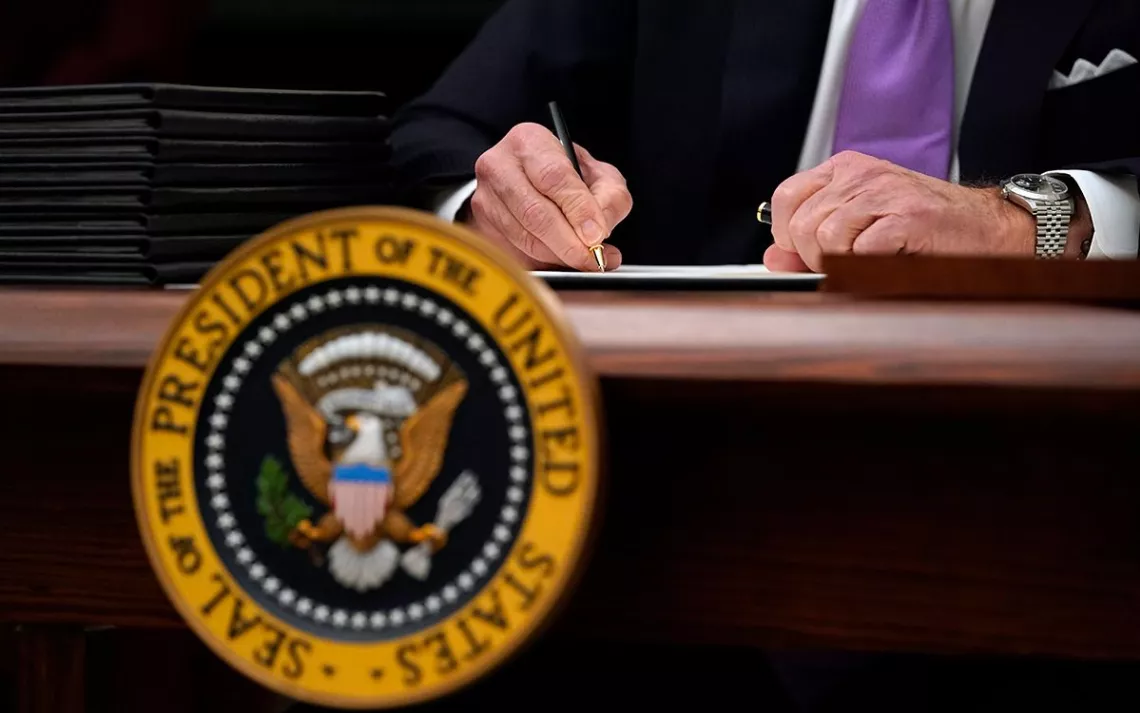Biden’s First Order of Business Was the Environment
Trump’s flimsy legacy, swept away with the stroke of a pen

Photo by AP Photo/Alex Bandon
Well that was quick. Within hours of Joe Biden’s inauguration, he had signed a stack of executive orders countermanding the stack of executive orders signed by his predecessor, Donald Trump, over the course of a long four years.
Just like that, US environmental policy was broadly returned to the status quo ante, the state of affairs at the end of the Obama-Biden administration. Apart from the tremendous waste of time, taxpayer money, and opportunity—a precious commodity as we struggle to avoid the worst of climate chaos—it will almost be as if Trump had remained a B-list television personality.
Here’s a rundown of Biden’s executive actions in his first days in office:
Rejoining the Paris climate accord
The Paris Agreement was ratified by nearly every nation on Earth in 2015. It’s a legally binding international treaty with a goal of limiting global warming to well below 2°C (3.6°F) over pre-industrial levels. Trump announced his intent to pull the US out of the accord in 2017, but the terms of the treaty dictated that he could not officially do so until the day after the presidential election—November 4, 2020. Despite Trump’s hostility, many states and localities had continued to honor the treaty’s terms. Thirty days after Biden sends a letter to the United Nations informing them of his action, the United States will rejoin the world’s fight for a livable climate.
Stopping the Keystone XL Pipeline
Keystone XL is an oil pipeline that would provide the final link between Canada’s vast tar-sands pits with refineries on the US Gulf Coast. For a dozen years, it has been a flashpoint for climate activists seeking to avoid new dirty fossil fuel developments (see Paris Agreement, above), farmers whose land it would cross, and Native American nations, particularly the Rosebud Sioux Tribe, the Fort Belknap Indian Community, and the Gros Ventre (Aaniiih) Tribes, for whom it was an issue of tribal sovereignty and treaty rights. Obama had rejected the pipeline in 2015, but Trump gleefully okayed it as one of his first acts in office. Even so, pipeline backers were frustrated by the US Supreme Court, which in the summer of 2020 refused to fast-track construction, delaying it until 2021. Biden’s revocation of the pipeline’s federal permit means that that date will pass as well, putting the $8 billion project in limbo.
Ending plans to drill for oil in the Arctic Refuge
An environmental battle even longer than Keystone XL has been the effort to protect the coastal plain of the Arctic National Wildlife Refuge in far northern Alaska from oil drilling. Democratic presidents have long opposed it, but the Republican-led Congress voted to open it in 2017, requiring two lease sales by 2024, the first to occur no later than 2021. The Trump administration rushed through an environmental review but did not get around to staging the sale until January 6—the same day Trump dead-enders stormed the US Capitol. On January 20, Biden slammed the juggernaut into reverse, signing a temporary moratorium on all drilling activity in the refuge. (Regardless of his action, the market has already spoken: Getting oil from the refuge would be extraordinarily expensive, US banks are refusing to finance it, there’s an oil glut already, and no major oil company deigned to bid at Trump’s auction.)
Restoring national monuments
One of Barack Obama’s key environmental achievements was the establishment of the Bears Ears National Monument in Utah and the Northeast Canyons and Seamounts Marine National Monument off the coast of New England. As part of his campaign to reverse all things Obama, Trump’s Interior Department fractured the former—removing protections from more than 2 million acres of it and neighboring Grand Staircase–Escalante National Monument—and opened the latter to fishing. Biden directed his Interior Department to review the monuments’ boundaries, the first step in what may be a lengthy legal process to restore them to their previous size and protection.
Freezing regulations
On January 20, Biden’s chief of staff Ron Klain issued a memo to all federal agencies, freezing all new or pending Trump regulations pending review. These included more than 100 administrative rules and regulations dealing with clean water, clean air, oil and gas development, endangered species, and more. The Interior Department, for example, is putting the brakes on efforts to withdraw protections for the sage grouse on millions of acres of federal land in seven states. In some cases—like protecting ephemeral wetlands and streams or purging industrial processes of toxic mercury—the effort will require all new regulations and may take years. Biden is also expected to reverse Trump’s weakening of automotive fuel-efficiency standards and to drop efforts to take away California’s ability to set tougher limits.
That Donald Trump could wreak such damage, and Joe Biden can single-handedly repair it, is part of a broader process that has been playing out across the federal government in recent decades, wherein Congress cedes more and more power to the Executive. It used to be that US environmental policy was the result of sweeping, bipartisan congressional action: the Clean Water Act, Clean Air Act, Endangered Species Act. But as the GOP hardened into a rigidly anti-environmental force, environmental progress has increasingly come to depend on executive fiat and administrative rulemaking.
That system makes it possible to quickly banish the long nightmare of Donald Trump. But, as former Sierra Club executive director David Brower used to say, it means no victory is permanent.
“We never win. If someone pours the concrete for a dam, they’ve won. If I save Glen Canyon, I haven’t won. I’ve just got a stay of execution.”
 The Magazine of The Sierra Club
The Magazine of The Sierra Club



